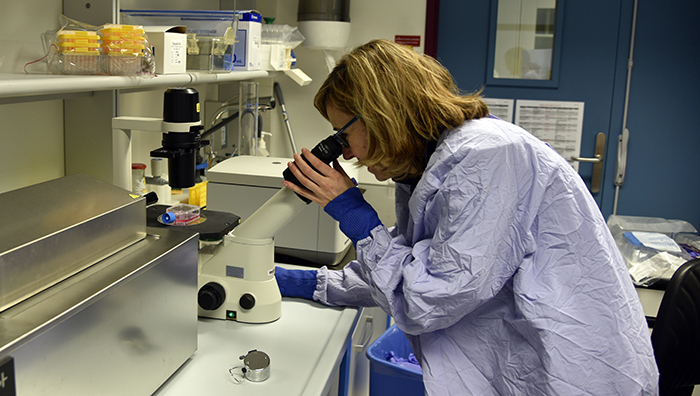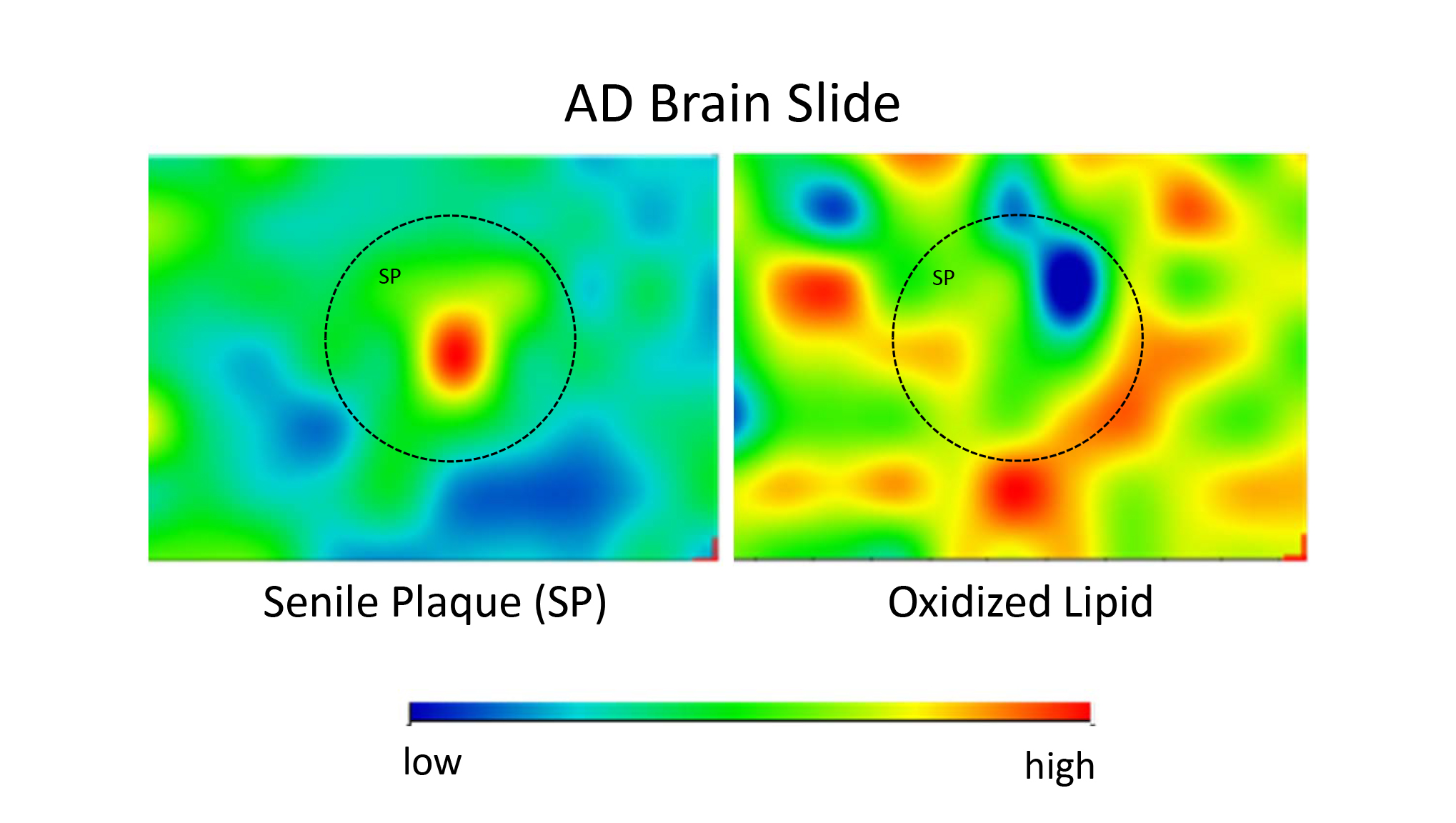- Home
- News
- General News
- Getting to the core...
Getting to the core of Alzheimer’s #worldalzheimersday
21-09-2017
Today it is World Alzheimer’s day. It affects 44 million people worldwide and it is foreseen to affect 135 million people by 2030, according to Alzheimer’s Disease International. Researchers worldwide are racing against time for a clear insight into its origins and, hopefully, a future treatment of the disease. Different techniques at the ESRF are being extensively used in this quest.
Every 3 seconds a new case of dementia occurs somewhere in the world. Dementia affects 50 million people worldwide and 60% of all cases correspond to Alzheimer’s disease. Despite such a big predominance in our lives, Alzheimer’s origin is still a mystery in 95% of cases. Scientists at the ESRF and other institutes are using different techniques at the synchrotron to try to unveil what triggers this devastating disease.
There are two kinds of Alzheimer’s: one that only accounts for 5% of the cases, has its onset at around 35-40 years of age and is caused by mutations in genes and a second one, which accounts for 95% of the cases and has an onset after 65 years of age. The origin of the latter has the scientific community puzzled. “There is a well-established hypothesis that claims that amyloid plaques are generated in the brain and this leads to cognitive impairment. However, in recent years research has shown that some people may have plaques and be Alzheimer’s-free and the other way round. So the correlation between amyloid and memory loss is not so clear. We think there might be other triggers”, explains Montse Soler López, scientist at the ESRF who is focused on the research on this disease. “The only thing we are sure about is that it is linked with ageing”, she asserts.
So researchers have been focusing on parts of the body that degrade dramatically with age. Neurons, for example, are long-lived cells, meaning that they don’t renew themselves like other cells do. Neurons lodge mitochondria, which are so-called the “powerhouse of cell” because of their active role generating energy in the body. With time, mitochondria suffer oxidative stress and this leads to their malfunction. It has been recently discovered that people with Alzheimer’s may have an accumulation of amyloids inside mitochondria (previously it was thought amyloids were only outside the neurons). Montse Soler is trying to find whether there is a link between mitochondrial dysfunction, presence of amyloids and early disease symptoms. “We believe that malfunctioning of the mitochondria can take place 20 years before the person shows symptoms of the disease”.
 |
|
Montse Soler in the lab. |
An important difficulty with Alzheimer’s is that it is intrinsically a human disease, which makes research only possible post-mortem, and because those affected are at an old age it is difficult to gauge what causes the illness versus what are just degradations that take place in the body throughout our lifetime and that are not related to the illness.
The ESRF has proven an indispensable tool in Soler’s research. She uses X-ray crystallography, small-angle X-ray scattering and electron microscopy to elucidate the molecular architecture of mitochondrial protein complexes and their interplay with amyloid pathology.
Focusing on the plaques
It is not only these techniques that can unveil answers in Alzheimer’s research. Scientists from the Istituto Italiano di Tecnologia in Genova (Italy) used other techniques, such as synchrotron Fourier transform infrared (FTIR) spectroscopy on ID21 and X-ray diffraction on ID13 to study amyloid fibril formation in Aβ protein, one of the main hallmarks of Alzheimer’s disease. The team has focused on the role of lipid membranes and other biochemical agents (acetylcholinesterase/curcumin) in the formation of amyloids in presence of nanostructured surfaces. Angelo Accardo, leading investigator of the research project, and currently working at the Laboratoire d'analyse et d'architectures des systèmes (LAAS-CNRS) in Toulouse, explains the benefits of the ESRF: ”The synchrotron facility played a crucial role in our investigation on amyloidal aggregation mechanisms. For the first time, we integrated nanostructured surfaces in a synchrotron beamline, where by combining droplet microreactor environments with in-situ FTIR spectroscopy, small and wide angle X-ray scattering we shined light on how Amyloid-β protein fibrillation can be sensitively influenced by external biocompounds and peculiar microfluidic flows”.
Another team, this time from the Universitat Autònoma de Barcelona, led by Josep Cladera and Núria Benseny (former ESRF postdoctoral researcher and currently at ALBA Synchrotron), is using infrared imaging and X-ray fluorescence to locate the Alzheimer’s peptide aggregates in brain samples and in cell culture. Amyloid peptides may play a central role in the sequence of events that leads to neurodegeneration. They try to locate these both in deceased Alzheimer’s patients, Alzheimer mice models and as well in cell cultures using model brain cells. “Our aim is to detect the aggregates in situ and study their structure in order to try to identify amyloid species that could form at early stages (relevant in the search for markers that could facilitate and early detection of the pathology), and to link their properties with the oxidation state of the tissues surrounding them, as well as with alterations in the distribution of metal cations in the brain tissue”, explains Josep Cladera.
 |
|
In situ Infrared imaging of Alzheimer’s brain tissue shows co-localization of amyloid aggregates (left panel) with lipid peroxidation (right panel). The red (high amyloid aggregation level) spot in the right panel corresponds to an amyloid aggregate. The right panel shows the level of lipid oxidation in the same brain sample (red means a high lipid oxidation level): lipid oxidation is high in the area immediately surrounding the peptide aggregate. Credits: J. Cladera. |
Their studies, carried at ID21 and ID16, in collaboration with Hiram Castillo and Marine Cotte, have shown, so far, that in patients with Alzheimer’s, the plaques and their immediate surroundings are always characterised by a presence of oxidized lipids, as opposed to the samples from non-Alzheimer’s individuals who have or don’t have plaques. “We showed that lipid oxidation could be a key factor in the development of this disease, closely related to the appearance and localization in the tissue of amyloid plaques”, adds Cladera. “This outcome is interesting and it contributes to the research results that are being published worldwide. There is, however, still a long road ahead until we are able to fight the disease”, he says.
Text by Montserrat Capellas Espuny
References:
Accardo, A. et al, Langmuir, 2014, 30, 3191−3198.
Accardo, A. et al., ACS Applied Materials & Interfaces, 2015, 7 (37), 20875–20884.
Benseny-Cases, N. et al, Anal. Chem., 2014, 86 (24), pp 12047–12054.
Giachin G, et al, Front Mol Biosci, 3:43, 2016.
Klementieva, O. et al, Biomacromolecules, 2013, 14:3570-80.
Top image: credit for cover photo: Wild pixel /Istockphoto



